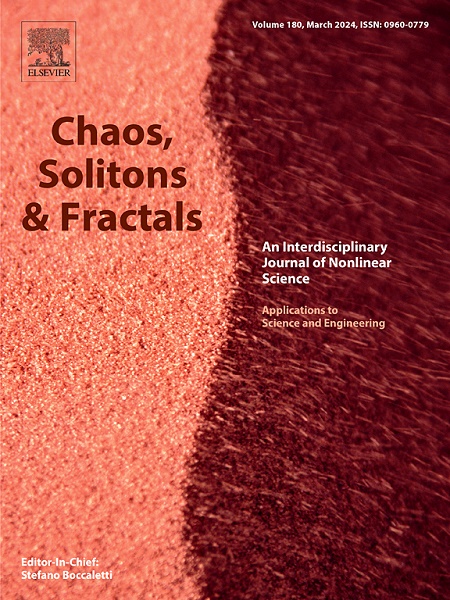Light-powered self-swing of a bistable magnetic pendulum utilizing liquid crystal elastomer fibers
IF 5.3
1区 数学
Q1 MATHEMATICS, INTERDISCIPLINARY APPLICATIONS
引用次数: 0
Abstract
Light-powered self-oscillation allows for the direct absorption of heat from ambient illumination to maintain its movement, making it a valuable technology for sensors, energy harvesters and soft robots. However, achieving self-oscillation in pendulum systems remains experimentally challenging. To overcome this limitation, we experimentally proposes a bistable magnetic pendulum that utilizes magnetic forces to provide a lateral pulling force, where the interplay of gravity and magnetic forces allows the pendulum to transition between the light zone and the dark zone, offering a novel mechanism for self-oscillation. Base on the light-responsive characteristic curve of LCE fiber calibrated experimentally, a theoretical model for the bistable magnetic pendulum is established to investigate the dynamic behaviors of the self-swing. Numerical calculation shows that the bistable magnetic pendulum has three modes motion: static, single-periodic self-swing, and complex-periodic self-swing, which aligns with the experimental observations. The self-swing is originated from alternating gravity-to-magnetic transition in dark and magnetic-to-gravity transition in light. Furthermore, the motion state, amplitude, and period of the LCE magnetic pendulum can be controlled by adjusting the light power, magnetization coefficient and thermal time ratio. The proposed bistable magnetic pendulum, with advantages such as not requiring rapid material response, a wide range of adjustable periods, and a simple structure, can provide potential applications in environmental monitoring, robotics, and energy harvesting.
利用液晶弹性体纤维的双稳磁摆的光动力自摆
光驱动的自振荡允许直接吸收来自环境照明的热量来保持其运动,使其成为传感器,能量收集器和软机器人的宝贵技术。然而,在实验上实现摆系统的自振荡仍然具有挑战性。为了克服这一限制,我们通过实验提出了一种双稳态磁摆,利用磁力提供横向拉力,其中重力和磁力的相互作用允许摆在亮区和暗区之间转换,提供了一种新的自振荡机制。在实验标定的LCE光纤光响应特性曲线的基础上,建立了双稳态磁摆的理论模型,研究了双稳态磁摆自摆的动力学行为。数值计算表明,双稳态磁摆有静态、单周期自摆和复周期自摆三种运动模式,与实验结果一致。自摆动是由黑暗中引力到磁的交替转变和光明中磁到引力的交替转变引起的。此外,可以通过调节光功率、磁化系数和热时间比来控制LCE磁摆的运动状态、振幅和周期。所提出的双稳态磁摆具有不需要快速材料响应,可调周期范围广,结构简单等优点,可以在环境监测,机器人和能量收集方面提供潜在的应用。
本文章由计算机程序翻译,如有差异,请以英文原文为准。
求助全文
约1分钟内获得全文
求助全文
来源期刊

Chaos Solitons & Fractals
物理-数学跨学科应用
CiteScore
13.20
自引率
10.30%
发文量
1087
审稿时长
9 months
期刊介绍:
Chaos, Solitons & Fractals strives to establish itself as a premier journal in the interdisciplinary realm of Nonlinear Science, Non-equilibrium, and Complex Phenomena. It welcomes submissions covering a broad spectrum of topics within this field, including dynamics, non-equilibrium processes in physics, chemistry, and geophysics, complex matter and networks, mathematical models, computational biology, applications to quantum and mesoscopic phenomena, fluctuations and random processes, self-organization, and social phenomena.
 求助内容:
求助内容: 应助结果提醒方式:
应助结果提醒方式:


